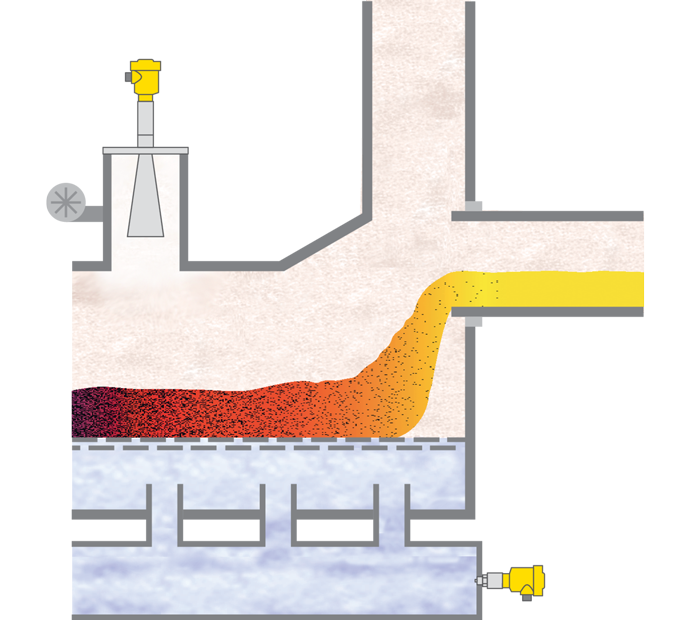Lime supplier controls clinker level with VEGAPULS 69
Lime plays a larger role in our lives than one might assume. The mineral can be found in many everyday products from glass to sugar and in the production of commonly-used materials, including metals and plastics. Good thing there are companies like Lhoist North America to provide us with lime and other minerals we depend on.
Application overview: clinker cooler
The clinker cooler is an important application in cementitious materials production. At the Lhoist facility, limestone is heated inside a rotary kiln at temperatures exceeding 2,000° F. This hot, fused material is called clinker, and it transports out of the kiln to a cooler. Clinker must be cooled with a continuous stream of air before it can be stored.
Level measurement inside the cooler is important for maintaining process efficiency and for protecting against overfill conditions. Due to the harsh environment inside the cooler, mining professionals turn to radiometric instruments for level measurement in this application. While they deliver reliable measurements, radiometric detectors present their own challenges.
The clinker coolers on the Lhoist site present a few extraordinary challenges that require an extraordinary radar level sensor. One of those challenges is mounting. Attached to each cooler is a four-foot standpipe on which the sensor is mounted to avoid the vessel’s extreme heat. The pipe creates a narrow path to the clinker, and this path is too narrow for most bulk solids radar sensors, as the radar beam contacts pipe walls and creates excessive noise in the measurement. Additionally, the pipe is mounted at an extreme angle aimed at the cooler's opposite wall near the bottom.
VEGAPULS 69: an innovative solution
Under the advice of VEGA advisors and local representative BBP Sales, Lhoist commissioned a VEGAPULS 69 with a 4” process connection for installation on each clinker cooler standpipe. A non-contact radar sensor for bulk solids level measurement, the VEGAPULS 69 operates with a transmission frequency of 80 GHz. This high frequency radar sensor emits a beam narrow enough to travel the pipe’s narrow path without contacting its walls and creating excessive signal noise. Beam angles vary by antenna size; in this case the radar sensor emitted a 4° beam.
All parties involved - Lhoist, BBP, and VEGA Americas - had heard of through-air radar sensors melting due to the extreme heat. To avoid such a horror show and maintain level measurement in the clinkers, air purges were included to keep hot air away from the sensors.
Since installing them the sensors have been working reliably. Users receive an unobstructed signal with no false echoes and measure product up to about three feet from the sensor.
Lhoist’s clinker coolers presented extraordinary challenges that could only be overcome with an equally extraordinary radar level sensor. With the help of their partners at BBP Sales and VEGA Americas, the lime and limestone supplier found everything it needed in the VEGAPULS 69.
Watch this for more info on the superior focus of the VEGAPULS 69
We need your consent
This content is provided by an external provider. If you activate the content, personal data may be processed and cookies set.
Related applications
Clinker cooler
Level and pressure measurement in the clinker cooler
To produce cement, the raw meal is burned to clinker in a long rotary kiln. After leaving the rotary kiln, the clinker has a temperature of up to +1300 °C and must be cooled down to a temperature of about +200 °C for further storage. To achieve this, the clinker bed is cooled with a continuous stream of air. Pressure monitoring is required in the lower part of the clinker cooler to make the cooling as effective as possible. The material height of the hot clinker, at over 1000 °C on the conveyor belt, also has to be reliably measured.

Reliable
Reliable monitoring of cooler process
Cost effective
Optimal cooling with minimum energy expenditure
User friendly
Maintenance-free measurement
Related products
Export this article
Download as PDFShare this article
Comments ({{comments.length}})
{{getCommentAuthor(comment, "Anonymous")}} {{comment.timestamp | date : "dd.MM.yyyy HH:mm" }}
{{comment.comment}}






